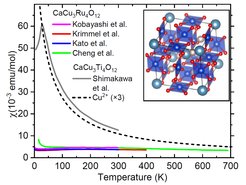CaCu3Ru4O12: A High-Kondo-Temperature Transition-Metal Oxide
The Kondo effect, a hallmark of the physics of correlated electrons, is extremely rarely observed in transition metal oxides. Over half a century after its discovery, the study of the Kondo physics and related phenomena is largely limited to rare-earth compounds. Here, an international team led by scientists from the MPI CPfS, the Osaka Prefecture University, and the TU Wien demonstrate that Kondo physics is realized in CaCu3Ru4O12, a transition metal oxide with a perovskite structure.
Transition-metal oxides host a surprisingly rich variety of physical properties such as high-temperature superconductivity or a colossal sensitivity of electrical resistance to magnetic fields. These behaviours originate from a delicate balance between the kinetic and Coulomb interaction energies of constituent electrons. However, a hallmark of the correlated electron physics — the Kondo effect, which describes the scattering of electrons in a material due to magnetic impurities — is very rarely observed in transition-metal oxides.
Scientists from the MPI CPfS, in collaboration with colleagues from the Osaka Prefecture University, Kyoto University, Hiroshima University, and Waseda University from Japan, the TU Wien from Austria, the National Synchrotron Radiation Research Center in Taiwan, POSTECH in Korea, and the University of Augsburg as well as the Luther University Halle-Wittenberg from Germany demonstrate that Kondo physics is realized in CaCu3Ru4O12 (CCRO), a transition metal oxide with a perovskite structure [1].

The study started with the spectroscopic verification that the Cu ions are divalent, and therefore magnetic. Yet, the magnetic susceptibility of CCRO displays a behaviour that is very far from Curie-Weiss, see Fig. 1. There are also no indications at all for magnetic order, and thus, it is clear that there must be some sort of screening mechanism at play that suppresses the magnetic signal.
The team carried out photoemission spectroscopy experiments (see Fig. 2a) using a very wide range of photon energies in the synchrotron facilities of Spring-8 (Japan), NSRRC (Taiwan), and PLS (Korea), within the framework of the Max Planck-POSTECH-Hsinchu Center for Complex Phase Materials. The wide range of energies allowed to combine the bulk-sensitivity offered by hard X-rays, crucial in compounds with such large unit cells, together with the higher sensitivity to the Cu 3d contributions in the so-called vacuum UV range, necessary to verify finer details of the electronic structure of the Cu. See Fig. 2a. Measurements were performed on high quality samples synthesised by multiple groups to ensure the consistency of the study. Dynamical mean-field theory calculations were then performed to accurately explain the experimental spectra, see Figs. 2b and 2c. The results show that the copper spins exhibit Kondo behaviour with a Kondo temperature in the range of 500–1000 K. The finding that the Kondo temperature is very high is also the key to reconcile contradictory conclusions of existing studies on this material.
In perspective, over half a century after its discovery, the study of Kondo physics and related phenomena is largely limited to rare-earth compounds. The present work now brings these investigations firmly to transition-metal oxides. In particular, the AA’3B4-xB’xO12 perovskite material class studied here provides a new platform for integrating competing quantum phenomena in strongly correlated electron systems: with the A’ site occupied by the ‘Kondo’ Cu, there is an immense amount of substitutional possibilities for the A, B, and B’ sites.

[1] D. Takegami et al. Phys. Rev. X 12, 011017 (2022)












